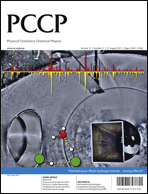In this article we present the first systematic study of the additive properties (i.e. degree of additivity) of the carbohydrate–aromatic moiety CH–π dispersion interaction. The additive properties were studied on the β-D-glucopyranose, β-D-mannopyranose and α-L-fucopyranose complexes with the naphthalene molecule by comparing the monodentate (single CH–π) and bidentate (two CH–π) complexes. All model complexes were optimized using the DFT-D approach, at the BP/def2-TZVPP level of theory. The interaction energies were refined using single point calculations at highly correlated ab initio methods at the CCSD(T)/CBS level, calculated as EMP2CBS + (ECCSD(T) − EMP2)Small Basis. Bidentate complexes show very strong interactions in the range from −10.79 up to −7.15 and −8.20 up to −6.14 kcal mol−1 for the DFT-D and CCSD(T)/CBS level, respectively. These values were compared with the sum of interaction energies of the appropriate monodentate carbohydrate–naphthalene complexes. The comparison reveals that the bidentate complex interaction energy is higher (interaction is weaker) than the sum of monodentate complex interaction energies. Bidentate complex interaction energy corresponds to 2/3 of the sum of the appropriate monodentate complex interaction energies (averaging over all modeled carbohydrate complexes). The observed interaction energies were also compared with the sum of interaction energies of the corresponding previously published carbohydrate–benzene complexes. Also in this case the interaction energy of the bidentate complex was higher (i.e. weaker interaction) than the sum of interaction energies of the corresponding benzene complexes. However, the obtained difference is lower than before, while the bidentate complex interaction energy corresponds to 4/5 of the sum of interaction energy of the benzene complexes, averaged over all structures. The mentioned comparison might aid protein engineering efforts where amino acid residues phenylalanine or tyrosine are to be replaced by a tryptophan and can help to predict the changes in the interactions. The observed results also show that DFT-D correctly describes the CH–π interaction energy and their additive properties in comparison to CCSD(T)/CBS calculated interaction energies. Thus, the DFT-D approach might be used for calculation of larger complexes of biological interest, where dispersion interaction plays an important role.

You have access to this article
 Please wait while we load your content...
Something went wrong. Try again?
Please wait while we load your content...
Something went wrong. Try again?


 Please wait while we load your content...
Please wait while we load your content...